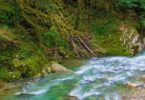Desert Quiz Questions and Answers:
How many countries does the Sahara desert touch?
(a) 7
(b) 9
(c) 10
(d) 11
What is the name of the desert that covers much of Southern Africa?
(a) Kalahari
(b) Sahara
(c) Atacama
(d) Mojave
Driest place on Earth is __
(a) Sonoran Desert
(b) Arabian Desert
(c) Gobi Desert
(d) Atacama Desert
Which of the following reasons is responsible for the lack of vegetation in the deserts?
(a) Heavy volume of sand
(b) Absence of B-horizon in the soil
(c) High temperature
(d) Lack of rainfall
How much of the Earth’s land surface is desert?
(a) 1/10th
(b) 1/5th
(c) 1/3rd
(d) 1/6th
What is the name of the desert that covers much of Eastern China and Mongolia?
(a) Sahara
(b) Arabian
(c) Gobi
(d) Great Basin
Related: Water Trivia Questions
World Day to combat desertification and drought is observed on:
(a) June 17
(b) June 20
(c) April 17
(d) July 20
The process of land becoming a desert is called:
(a) Desertored
(b) Deserting
(c) Desensitization
(d) Desertification
The Gobi Desert lies in which area?
(a) Australia
(b) Africa
(c) Asia
(d) America
What is the desert’s name covering much of Oman and the United Arab Emirates?
(a) Thar
(b) Arabian
(c) Great Sandy
(d) Gibson
Extensive deserts occur in the western tropical regions of continents because :
(a) of easterly trade winds.
(b) cold ocean currents flow along the western coasts.
(c) of the effect of offshore easterly trade winds and cold ocean currents.
(d) the rate of evaporation is greater along the western margin areas.
The biggest desert in Australia?
(a) The Great Victoria
(b) Great Sandy
(c) Tanami
(d) Simpson
Related: The Ultimate Quiz On Disaster Management
Why are deserts icy at night?
(a) due to low humidity levels
(b) due to low humidity levels
Deserts occur in areas of
(a) Adverse human disturbance
(b) Underground saline water
(c) Little underground water
(d) Rainshadow
What is the name of the desert that covers much of Northern Africa?
(a) Atacama
(b) Sahara
(c) Gobi
(d) Great Basin
Where are the hot deserts generally found?
(a) On the eastern margins of the Tropics
(b) On the western margins of the Tropics
(c) Nearer the Equator
(d) In the middle of the Continents
Desertification can be checked by
(a) plugging gullies
(b) checking over-grazing
(c) contour plowing
(d) forming shelter belts
What is the name of the desert that covers much of Western Australia?
(a) Great Sandy
(b) Gibson
(c) Simpson
(d) Tanami
Related: Climate Change Quiz
The biggest desert in the world is the –
(a) Antarctic
(b) Arctic
(c) Russian
(d) Sahara
What is the name of the desert that covers much of Northern Chile and Southern Peru?
(a) Atacama
(b) Kalahari
(c) Mojave
(d) Great Basin
In a desert region, soil erosion can be checked by
(a) Tree plantation/afforestation
(b) Crop rotation
(c) Contour ploughing
(d) Using farm manure
What is the largest hot desert in the world?
(a) Sahara
(b) Arabian
(c) Gobi
(d) Sonoran
In which part of Africa is the Sahara located?
(a) Eastern
(b) Western
(c) Northern
(d) Southern
Related: Biodiversity Multiple Choice Question and Answers
What is the name of the desert that covers much of Northern Mexico and the Southwestern USA?
(a) Mojave
(b) Sonoran
(c) Atacama
(d) Sahara
Where are the hot deserts generally found?
(a) On the eastern margins of the Tropics
(b) On the western margins of the Tropics
(c) Nearer the Equator
(d) In the middle of the Continent
What is the name of the desert that covers much of Central Asia?
(a) Sahara
(b) Gobi
(c) Arabian
(d) Thar
What is the name of the desert that covers much of Southern California, USA?
(a) Great Basin
(b) Sonoran
(c) Mojave
(d) Chihuahuan






